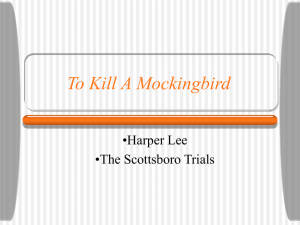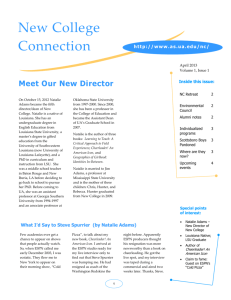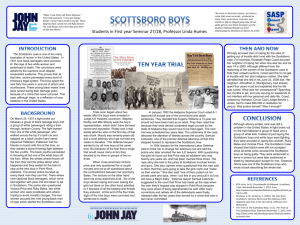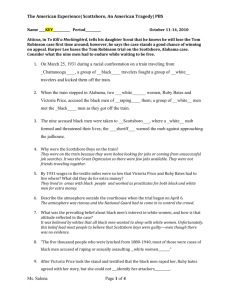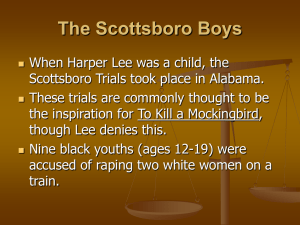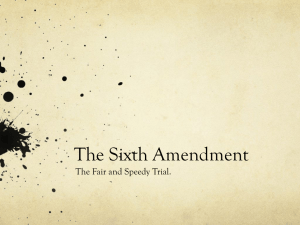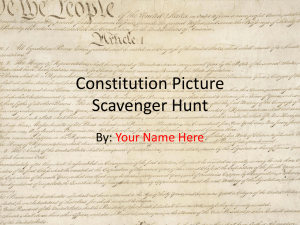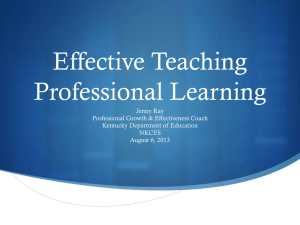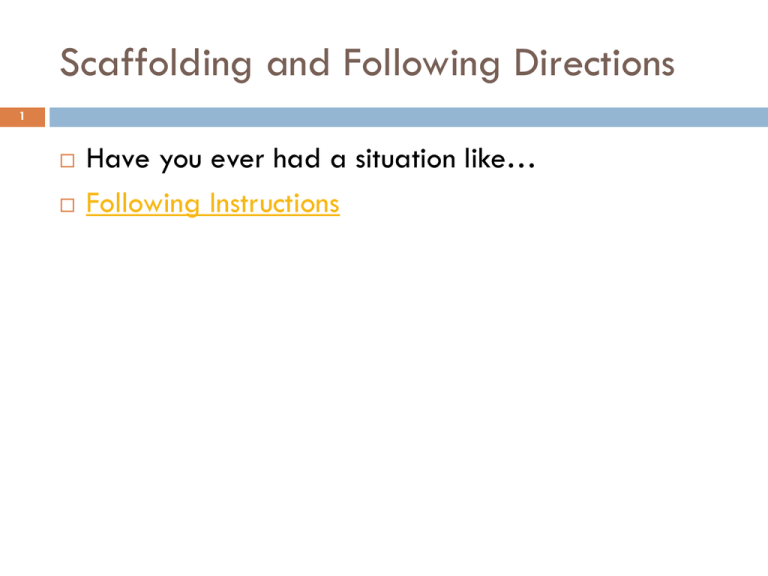
Scaffolding and Following Directions
1
Have you ever had a situation like…
Following Instructions
2
And now for something completely
dirfferent…
3
RACISM, DUE PROCESS AND THE
SCOTTSBORO RAPE CASE OF 1932: USING
WRITING TO EXPLORE CAUSE AND EFFECT
AND HISTORICAL SIGNIFICANCE
Writing in American History
Inquiry Question…
4
How can techniques of
scaffolding be applied to
historical content and writing
historically in the context of
understanding the historical
significance of the Scottsboro
rape trial?
http://writingsonthewall.edublogs.org/fi
les/2011/01/scottsboro-1t7p4hu.jpg
http://www.openmarket.org/wpcontent/uploads/2009/12/supreme-court.jpg
Why writing on the Scottsboro Trial?
5
The right to criminal due process is a very important but
often overlooked Constitutional guarantee
The Scottsboro Trial exemplifies the impact of racism in
America beyond segregated facilitates and economic
subjugation in an era often overlooked by the popular
narrative.
I have shown Scottsboro: An American Tragedy from the PBS
Series American Experience for the past few years and
assigned essays. I wish to implement some tools introduced
in this class to improve this learning experience and the
quality of writing
I find that this is a timely and relevant opportunity to
introduce the task of writing in the disciplines
Some writing examples from
Scottsboro
6
Assignment last year had six questions:
E.g
4. How did the biases and prejudices of the
Scottsboro Community and Alabama on the whole
challenge the Sixth Amendment rights of citizens
accused of crime?
Students
tended to understand the difference between a
speedy and hasty trial
Students only in a very general way appreciated the role of
prejudice in a trial where the accusation was rape.
Students were unlikely to recall specific evidence supporting
the role of prejudice in this trial
Research Base/ Best Practice
7
“Learning to write requires frequent, supportive
practice. Evidence shows that writing performance
improves when a student writes often and across
content areas. Writing also affects reading
comprehension.” (Nagin, 12)
Research Base/Best Practice
8
“… research found that writing could develop higherorder thinking skills: analyzing, synthesizing, evaluating
and interpreting. The very difficulty of writing is a
virtue: it requires that student s move beyond rote
learning and simply reproducing information, facts,
dates and formulae. Students must also learn how to
question their own assumptions and reflect critically on
alternative or opposing points of view.” (M.
Shaughnessy, Errors and Expectations: A Guide to the
Teacher of Basic Writing, New York: Oxford University,
1977 quoted in Nagin, 22)
Research Base/Best Practice
9
“An effective assignment does more than ask
students to write about what they have read or
experiences. It engages students in a series of
cognitive processes such as analysis and synthesis,
so that they are required to transform the
information from the reading material or other
sources in order to complete the writing
assignment.” (Nagin, 47)
Research Base/Best Practice
10
“…expressive writing, a common writing-as-process
strategy, helped improve student retention in a
content-heavy subject.” (Robert Tierney, “Using
Expressive Writing to Teach Biology”, (Appendix D)
In A. Wotring and Robert Tierney (eds.) Two Studies
of Writing in High School Science, Berkley, CA: Bay
Area Writing Project, University of California, 1981
Quoted in Nagin, 52-53)
Research Base/Best Practice
11
Writing in the disciplines creates apprenticeship
situations for students where “students are not
understood as outsiders but fellow members of a
disciplinary community, albeit in the periphery.
…Writing is the vital link between knowing and
doing in the disciplines.” (Michael Carter and
Miriam Ferzli, “Writing to Learn by Learning to
Write in the Disciplines” Journal of Business and
Technical Communication July 2007)
Pennsylvania Standards: Reading
Writing, Speaking and Listening
12
1.4.11 B. Write complex informational pieces (e.g., research papers,
analyses, evaluations, essays).
1.5.11 A. Write with a sharp, distinct focus.
· Identify topic, task and audience.
· Establish and maintain a single point of view.
1.5.11 B. Write using well-developed content appropriate for the
topic.
· Gather, determine validity and reliability of, analyze and organize
information.
· Employ the most effective format for purpose and audience.
· Write fully developed paragraphs that have details and
information specific to the topic and relevant to the focus.
Pennsylvania Standards? Reading
Writing, Speaking and Listening
13
1.5.11 C. Write with controlled and/or subtle organization.
· Sustain a logical order throughout the piece.
Include an effective introduction and conclusion.
1.5.11 D. Write with a command of the stylistic aspects of
composition.
·
Use different types and lengths of sentences.
·
Use precise language.
1.5.11 E. Revise writing to improve style, word choice,
sentence variety and subtlety of meaning after rethinking
how questions of purpose, audience and genre have been
addressed.
1.5.11F. Edit writing using the conventions of language.
Pennsylvania Standards: Government
14
5.1.12 I I. Analyze historical examples of the
importance of the rule of law explaining the
sources, purposes and functions of law.
5.1.12 L. Analyze Pennsylvania and United States
court decisions that have affected principles and
ideals of government in civic life.
5.2.12 F F. Evaluate how individual rights may
conflict with or support the common good.
Pennsylvania Standards: History
15
8.1.12C. Evaluate historical interpretation of events.
8.3.12 C. Evaluate how continuity and change has
influenced United States history from 1890 to
present.
Step One: Anticipatory Set Due Process
and the Sixth Amendment
16
Share with students a story about a person who is
thrown into prison without a trial. Have students work
together in pairs to brainstorm ideas that relate to this
prompt: “Why might we consider the situation we
reviewed as unfair? What would keep a situation like
this from happening to you or any other American
citizen?”
Debrief student answers and then distribute copies of
the Sixth Amendment. Have students reconvene in their
groups and add to their answer. Debrief noting that
the Sixth Amendment makes six important qualifications
of criminal due process. This can be developed into a
quick write
Due Process and Equal Protection
17
Have students read the equal
protection clause of the Fourteenth
Amendment. Have partners discuss
what they think it means and lead a
brief discussion that clarifies this
clause and its connection to the Sixth
Amendment
The guarantees of the Constitution are
promises that are only as good as the
will of those who carry out the
promise. How might the existence of
racial prejudice make it difficult for a
community or court to provide due
process rights for all American
citizens?
http://www.evaneco.com/scales-of-justice.gif
Preview: Scottsboro: An American
Tragedy
18
Show the short preview from
Scottsboro: An American
Tragedy
Large Group: “In your
journals, predict how this
story might connect to the
issues of the Sixth and
Fourteenth Amendment that
we just discussed.”
http://images.buzzillions.com/images
_products/07/74/pbs-directamerican-experience-scottsboro-antragedy-dvd_4087778_175.jpg
Writing Task
19
Evaluate how the Scottsboro rape case represents the significance of
criminal due process and how the presence of prejudice challenges
rights granted to American citizens in the United States Constitution.
In this essay, be sure to:
Identify and explain how criminal due process is guaranteed in the United
States Constitution.
Identify and explain how equal protection is guaranteed by the United
States Constitution.
Summarize the events of the case and evaluate how these events reflect
the struggle to protect criminal due process through the prejudice of a
community
Review the Rubric
This question may be adapted for special needs students
A seminar approach may be used where students work in groups, each
group having a set of questions that they will respond, peer edit and
publish in a “historical journal” that examines this case.
Writing Support: The Writer’s Toolbox
for The Scottsboro Essay
20
Note: Historians, like defense lawyers, create
arguments that are built on investigation. You will
need to watch this movie thoughtfully in order to
have the material that you will need to successfully
make your argument. Supporting documents are
available on the class wiki
The toolbox will contain general directions on
historical writing, organizers for preparing content
for the essay, frameworks for pre-writing and
questions for peer and teacher writing conferences
Features of Exemplary Historical
Writing: The Clear Focus
21
Exemplary historical writing is clearly focused on a
relevant point (thesis).
Be
sure to read and re-read prompts and rubrics to be
sure your efforts are focused.
Keep the task or prompt in mind though all steps of the
process.
Features of Exemplary Historical
Writing: Historical Facts and Content
22
Exemplary historical writing analyzes relationships
between historical facts and understands their
context.
Cite evidence supporting their main point and make
clear connections between the evidence presented and
the main point.
Appreciate the connection between evidence and the
historical environment from which it comes.
Features of Exemplary Historical Writing:
Identifying relevant people, places and ideas
23
Exemplary historical writing identifies and explains
and gives the significance of relevant people,
places and ideas.
Be
sure to credit important facts in your writing to
clearly identified people, places and ideas.
Provide the geographic (where) and chronological
(when) background and how it connects to your point
Features of Exemplary Historical
Writing: Supporting a Point of View
24
Exemplary historical writing supports its point of
view though quoting relevant expert opinions,
statistics and primary sources.
Use
the words of the history-makers when possible to
support your main points.
Support your point of view with identified experts and
statistics.
Features of Exemplary Historical
Writing: Third Person Point of View
25
Exemplary historical writing is typically written in
the third person as the historian is the outside
observer making judgments about relevant people,
places and events.
The
term I or we is seldom acceptable as you make
historical observations unless they are autobiographical.
Be clear and specific as the situation allows when
making an observation. Do not leave pronouns like
“they” or “he” without an identifiable antecedent.
Features of Exemplary Historical
Writing: Polish and Sophistication
26
Exemplary historical writing is well planned and
edited and impresses the reader by its
sophistication and clarity.
Plan
and organize before writing.
Proof read and polish after reading
Periodic Debriefing
27
Stop the movie at the following points and provide
students the opportunity to work individually or in
groups to connect evidence to the writing prompt
Following the First Appeal: Norris v Alabama
The ILD contended that the defendants lacked adequate counsel
Following Judge Horton’s call for a new trial
Following Patterson v Alabama
The ILD contended that the exclusion of blacks from the jury
denied equal protection
Reinforce the role of the Supreme Court and its
relationship to the Constitution
Prewriting and Drafting
28
The Writing Toolbox sets up pre-writing I and prewriting II
Students will engage in peer conferencing using a
checklist from the Writing Toolbox
I will collect and review essays in preparation for
teacher conferences. This can be done as students
work on reading assignments in class.
My Goals for This Activity
29
Clearly laying out writing expectations and
providing students with a larger role though peer
conferences will help focus students to reach for
clearly delineated goals for their writing.
A more relevant and clear anticipatory set will
increase interest and focus on the main elements of
the story of the Scottsboro Case
Better scaffolding of content and breaking it down
to smaller parts will make students better prepared
to develop rich answers to the prompt
30

